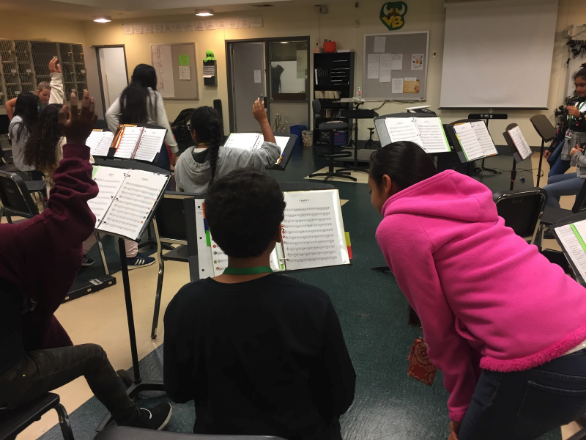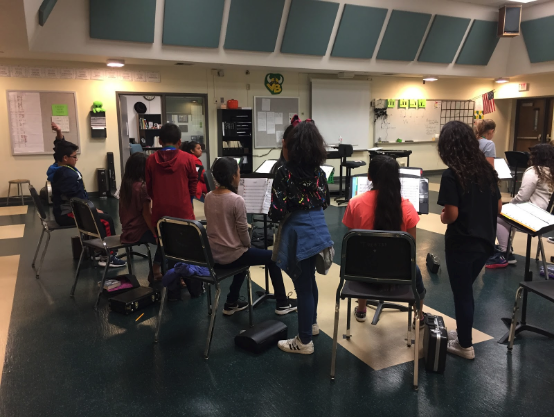Move faster, learn more, and make it fun!
Just like many other band programs in Texas, my students have specific objectives they have to complete each nine-weeks. On my band objective cards I have in bold lettering “Only the band director can pass off objectives!” At my school however, I am the only band director so the 1 to 143 teacher-to-student ratio means it can take a long time to get through even one objective.
I was becoming frustrated with how slow my students were achieving there objectives. It took forever to pass off our “Alphabet All-Star” lines, and we were only counting a few rhythm lines a day. The students weren’t engaged, and I felt like they were losing momentum. I took my problem to a colleague and asked him how he passes off so many objectives so quickly. He mentioned that he had band aides, a luxury my program does not have. He then suggested having the students who have already achieved the objective help me pass off other students.
I started by having students who have completed the entire objective help me pass off others. These top achieving students loved getting to walk around to pass off other students, but we were still moving slowly. Then I realized that a student who has only passed off one line can still teach another person how to be successful on that same line.
So, I changed the rules of the game.
New Rules
- Set a timer. Trust me on this. If you don’t set a time limit, they will do this the ENTIRE class period.
- Initially, I am the only one who can pass off a line. Students must raise their hand when they are ready to pass a line off.
- Once a student passes off a line, they get up, grab a sticker from my podium, and go back to their seat and place the sticker on their page.
- They then go to an individual who would like to pass off that same line OR go back to their seats to work on another line.
- Students who complete the entire page of rhythmic lines or “Alphabet All-star” then puts a sticker on the classroom chart meaning they have completed an objective.


Students who are ready to pass off a line raise their hands waiting for a classmate to help.
The Power of the Stickers
High Achieving Students:
My high achieving students are excited to move faster. They are also less likely to become bored. I can teach them more challenging concepts individually so they can continue to move forward without waiting for others. Then they can teach those concepts to the other high achievers (sometimes with my assistance). When I have a student who needs help learning a new concept, I can simply say, “Aaron, come show Josh how we count 8th notes.”


A student teaching another student how four eighth notes beamed together are counted the exact same way as they counted it on the previous rhythm chart where the eighth notes are only in pairs.
Middle Students:
The middle students don’t usually get the chance to show off, but this process allows them to step up and become leaders. While my high achieving students have a tendency to focus on their own advancement, my middle students are always willing to help their peers.


Notice that the girl being helped in the last image is now working with another student.
Low Achieving Students:
My lower achieving students get one-on-one time with me. I can spend the entire time working with one individual instead of feeling pressure to keep everyone moving forward: my class is moving forward without me. If I am having problems explaining a concept to a low achieving student, I can once again ask another student who can use “kid talk” and maybe they will understand it that way.
The best thing about giving my students the “power of the stickers” was watching my lower achieving students helping others. I had students walking around the room holding a finger up and saying with excitement, “Who needs help with line one?” How exciting it must be to be that kid! They get to show off for a brief second that they nailed a line and they get the chance to help another student.
Other Things I Noticed:
-
- Students are literally begging each other to pass off lines. “I need line five. Who has line five?!?!? Naomi, pleeeeeeeeaaaaassssseeee we only have 30 seconds left!!!!!”
- It gives me a couple of minutes to get my life together especially with attendance (which I still somehow forget to do Every. Single. Period.).
- It showed me that most of my students are ready to move faster, and that I was holding them back. When we counted in a large group, I would only count a few lines a day. Now they count through as many as they can get in four minutes.
- The kids are tough on each other, but also very understanding and caring.
- Because the students are teaching the concepts to other students, they are reinforcing their own learning!
- It gets them out of their seats, which they love. They have to walk up to get their stickers and they can roam the room looking for someone to help. If they can’t help anyone, they go back and try to pass off for me or another student.
- I get less frustrated when a student doesn’t understand a concept. When I run out of “tricks,” I ask a student to help out. Often times students have a better way of breaking concepts down that makes sense to their peers.
- The “lazy” kids see everyone else moving forward and give in. It’s now cool to pass off their lines. Hooray for positive peer pressure!
- I can always go back and ask students to count a line for me if I feel they got their sticker without counting it exactly right.
- The students who may be struggling with their instrument can have something they are successful at and can leave feeling like they’ve accomplished something that day.
- My beginners are learning to be competitive while also learning that there is no second string in band. They pump the brakes on their own sticker collection to help out a neighbor who is struggling.
- This process checks that “distinguished” box in our T-Tess rubric at multiple dimensions.
- Students collaborate positively and encourage each other’s efforts and achievements. 3.3
- Students take primary leadership and responsibility for managing student groups. 3.1
- Provides opportunities for students to self-monitor and self-correct mistakes. 2.1
- The ability for all students to set goals, reflect on, evaluate and hold each other accountable within instructional groups. 1.4
Expanding this for the future:
So far I’ve only experimented on this with the “Alphabet All-star” pass offs and our rhythm chart lines. I’m not sure if this could work with playing, but I am willing to try it out. It might require more training on what I’m expecting from a passed off line. I might alter it so I’m more selective with my sticker people. We already have group discussions on whose tone is the best and who played the most rhythmically accurate. They tend to have a good idea of what they need to sound like. I worry more about the feedback that they might give each other and may limit it to specific comments or sections of our rubric.
Overall, giving the power of the stickers to my students has improved the learning environment of my classroom. My students are moving much faster and are excited to play our new game.


